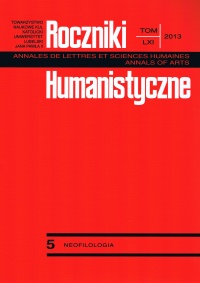The Topography of Confinement in Jane Eyre and “The Lady of Shalott”
Abstract
This paper is based on the assumption that it is possible to overcome generic boundaries and discern a shared language in the literary and visual arts. Its purpose is to demonstrate how literature and art rupture the Victorian ideal of angelic woman at home and allow us to enter intimate territories of female minds where free will goes against the sanctioned expectations. I will demonstrate this on the basis of Charlotte Brontë’s Jane Eyre, where a pilgrimage to maturity and emotional fulfilment is embodied as space. This text will be juxtaposed with Tennyson’s “The Lady of Shalott,” read as a representation of defiance of gender-ascribed confinement. One of this poem’s most potent pictorial images, Hunt’s engraving of 1857 (a basis for his later painting of 1905), capturing the Lady in the moment of fateful decision-making is compared with Jane Eyre’s other silent home-ridden character, Bertha Rochester. All three images, of Jane, Bertha and the Lady, realise in their own way a territorial relocation seen as necessary for an untrapping of femininity.
References
Bronfen, E. Over Her Dead Body. Death, femininity and the aesthetic. Manchester: Manchester University Press, 1993.
Brontё, Ch. Jane Eyre. http://www.gutenberg.org/files/1260/1260-h/1260-h.htm n. pag (Web. 20.12.2012).
Gilbert, S., Gubar, S. The Madwoman in the Attic. The Woman Writer and the Nineteenth-Century Imagination. New Haven: Yale Nota Bene, Yale University Press, 2000.
Marsh, J. Pre-Raphaelite Women, Images of Femininity in Pre-Raphaelite Art. London: Weidenfeld and Nicolson, 1995.
Poovey, M. “The Anathematized Race: The Governess and Jane Eyre.” In: S. Regan (ed.). The Nineteenth Century Novel. A Critical Reader. London: Routledge, 2005. 194-212.
Punter, D., Byron, G. The Gothic. Oxford: Blackwell Publishing, 2004.
Richardson, S.: Clarissa or, the History of a Young Lady. London: Dent, Everyman’s Library, 1962.
Tennyson, A. “The Lady of Shalott.” http://www.victorianweb.org/authors/tennyson/los1.html n. pag. (Web. 20.12.2012).
Tuan, Y.F. “Space and place: humanistic perspective.” In: C. Gale, G. Olsson (eds.). Philosophy in Geography. 387-427. http://apcg.uoregon.edu/amarcus/geog620/Readings/Tuan_1979_space-place.pdf (Web. 21.12.2012)
Woolf, V. A Room of One’s Own. Harmondsworth: Penguin Books, 1945.
Copyright (c) 2013 Roczniki Humanistyczne

This work is licensed under a Creative Commons Attribution-NonCommercial-NoDerivatives 4.0 International License.





